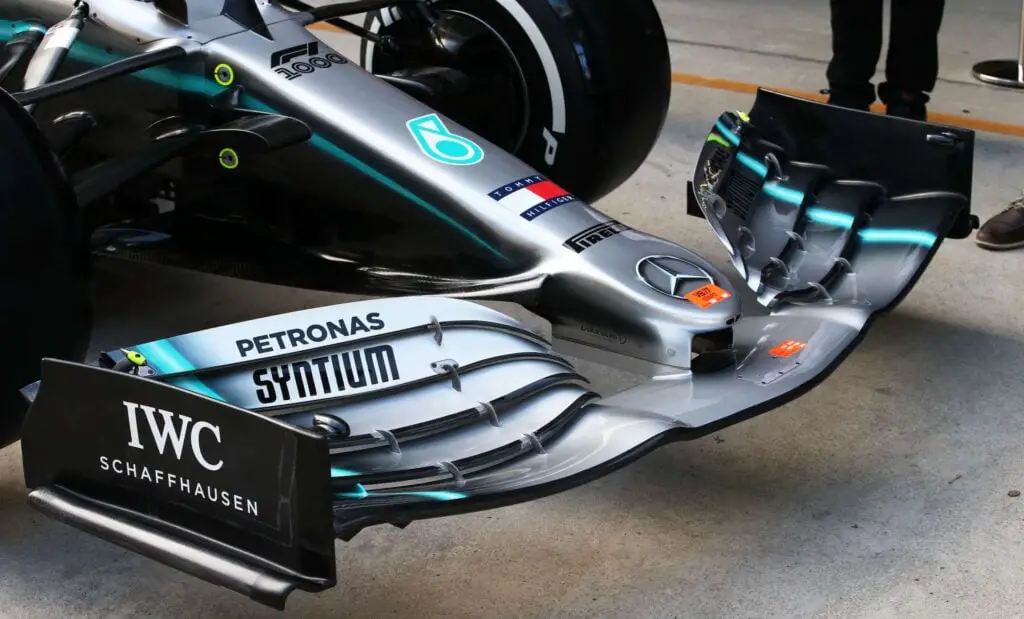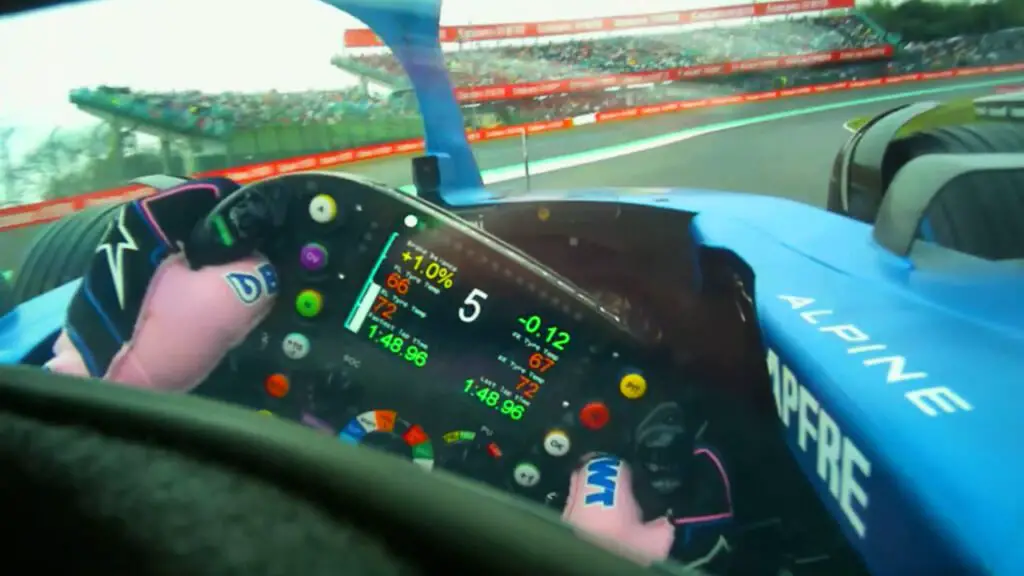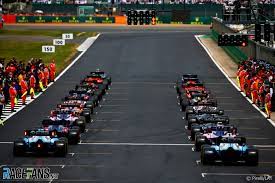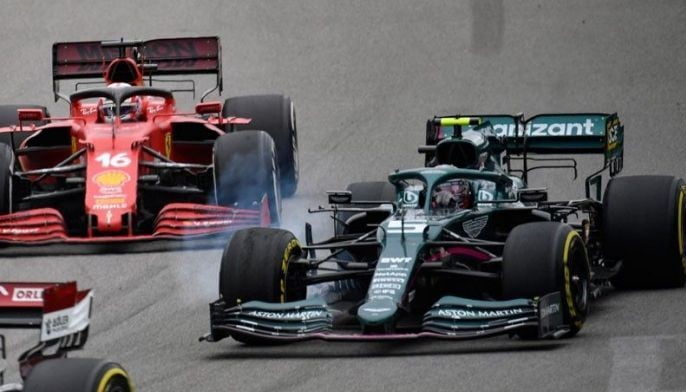It seems only a short while ago that we discussed the F1 2022 rules changes and the dramatic effect they would have on Formula One in the future. Here we are at the end of the 2022 F1 season, with the entire racing order turning upside down and Red Bull and Ferrari knocking Mercedes down. Will the F1 Rule changes for 2023 achieve the same result?
The 2023 F1 Rule Changes focus on improving safety, helping teams overcome a repeat of the porpoising problem, and trying to make the car’s performance a little closer together. They include changing the ride height, outlawing the Mercedes front wing, and improving safety.
In this article, we look at the 2023 F1 rule changes and explain in non-technical terms what they involve.
The 2023 F1 Rule Changes
The F1 Rule Changes are as follows.
- The F1 changes to the cars floors.
- The F1 car’s weight reduces (again.)
- The F1 2023 front wing changes.
- The F1 2023 roll hoop changes.
- There are more cameras.
- The fuel density check is stricter.
The 2023 F1 Rule Changes The Cars Floors
The FIA has revised the height of floors in the F1 cars.
Background To The Problem
The rules change the ride height and floor shape.
One of the factors which caused Mercedes’s downfall was the implementation of ground effect in the floors. Mercedes got the design wrong and ended up with the team suffering from serious “porpoising” on the high-speed straights.
The porpoising is caused by the ground effect pulling the chassis towards the track, and at a point, the floor “stalls” (just like in an aircraft.), so the chassis lifts up, at which point the whole cycle starts again.
The impact for the driver is that the car bounces up and down while traveling at speeds of +- 200 mph. Not only did this affect the car’s handling, but it also made it very uncomfortable (and possibly dangerous) for the driver.
Lewis Hamilton has said that now the 2022 Mercedes car has been retired, he never wants to drive it again.
The FIA’s Solution
The most effective way to remove porpoising from the equation is to lift the floor height of the cars.
The governing body originally proposed that the floor height be increased by 25mm for 2023. Teams that had resolved the problem argued against the 25mm figure, and finally, a height increase of 15mm was agreed upon.

2023 F1 rules – Ride Height
The make the floors stiffer. They reduce the deflection angle (the amount by which the floor bends) from 12mm up and 8mm down to 5mm in both directions.
The reasoning behind this is that the FIA wants to make it more difficult for the teams to use the edge of the floors to seal the underside of the F1 car.
Pressure creates at the “throat” (narrowest part of the floor.) The airflow accelerates, so downforce increases.
If it is too narrow, the air flow stalls around this point, causing the car to porpoise. The engineers raise the diffuser plate to stop this. The FIA mandates that it provides a margin with differing floor heights.
The 2023 F1 Rule Changes Reduce The Cars Weight (Again)
The minimum weight of the cars is now 796kgs.
This matches the 2022 F1 rule. In 2002 teams failed to meet the minimum.
The 2023 F1 Rule Changes The Front Wing
For the Canadian Grand Prix, Mercedes introduced a very clever front wing that increased the car’s downforce.

The FIA has dictates the design of the front wings. It prevents innovations like this happening in the future.
The 2023 F1 Rule Changes The Roll Hoop
After the scary 2022 accident at Silverstone involving Guanyu Zhou, the FIA has mandated changes to the roll bar.
The new regulations require this component to withstand 15g impacts.
From 2023 the roll bar withstands not just the vertical forces in a rollover accident but also the forward and back lateral forces.
There Are Bigger Mirrors In 2023
In the 2023 F1 rules the rearview mirrors increase in size. Thus reduces the blind spot from drivers approaching from the rear.
This may be the impetus the teams need to switch from mirrors to rearview camera systems.
The Number Of Cameras Increases
The inboard cameras in used in 2022 where successful. IN 2023 the number increases from six to seven.

This will now include a forward-facing helmet camera.
The Fuel Density Check Is Stricter
The rule regarding the temperature at which the fuel is measured is changed. The temperature requirement reduces from 20 degrees in 2022 to 10 degrees in 2023.
Previously teams exploited the rule enabling them to cool their fuel to a greater extent than other teams giving them an advantage over teams not cooling their fuel.
By mandating a lower maximum temperature, all teams will have the same fuel density, and therefore there will be no competitive advantage.
Exhaust Tail Pipes Are Changing
The new rule dictates the routing of the exhaust tailpipes. The rule reads as follows.
“Any wastegate tailpipe(s) through which all the wastegate exit fluids pass must have an internal cross-section less than 1500mm2, and all external surfaces must have a minimal aerodynamic effect on the external air stream.”
What Happens When A Driver Leaves The Car
A new rule dictates what happens if a driver leaves the car.
If a driver abandons his car, even for a short period, they withdraw it from the race.
It does not apply to sprint races. Or if the driver is facing suspension.
They Have Tightened Up The Grid Penalties
The penalties prevent a loophole Ferrari exploited in 2022
Ferrari replaced different components of Charles Leclerc’s engine at different times during the Belgium Grand Prix weekend in an attempt to evade the “back of the grid penalty,”

The FIA has changed the rule to state.
“accrued more than 15 cumulative grid position penalties, or who have been penalized to start at the back of the grid, will start behind any other classified driver.”
Conclusion
The 2023 rule changes tidy up the massive rule amendments in 2022. In implementing them, the FIA is intent on increasing the sport’s safety and removing some of the different teams’ competitive advantages.
References
https://en.wikipedia.org/wiki/History_of_Formula_One_regulations
The 2023 Formula One calendar is revealed (f1worldwide.com)
F1 Technical – F1Worldwide.com


I don’t think the title of your article matches the content lol. Just kidding, mainly because I had some doubts after reading the article.
Your point of view caught my eye and was very interesting. Thanks. I have a question for you.
I have read your article carefully and I agree with you very much. This has provided a great help for my thesis writing, and I will seriously improve it. However, I don’t know much about a certain place. Can you help me?
I agree with your point of view, your article has given me a lot of help and benefited me a lot. Thanks. Hope you continue to write such excellent articles.
Reading your article helped me a lot and I agree with you. But I still have some doubts, can you clarify for me? I’ll keep an eye out for your answers.
Great site
I think you have summed up Mercs position quite well